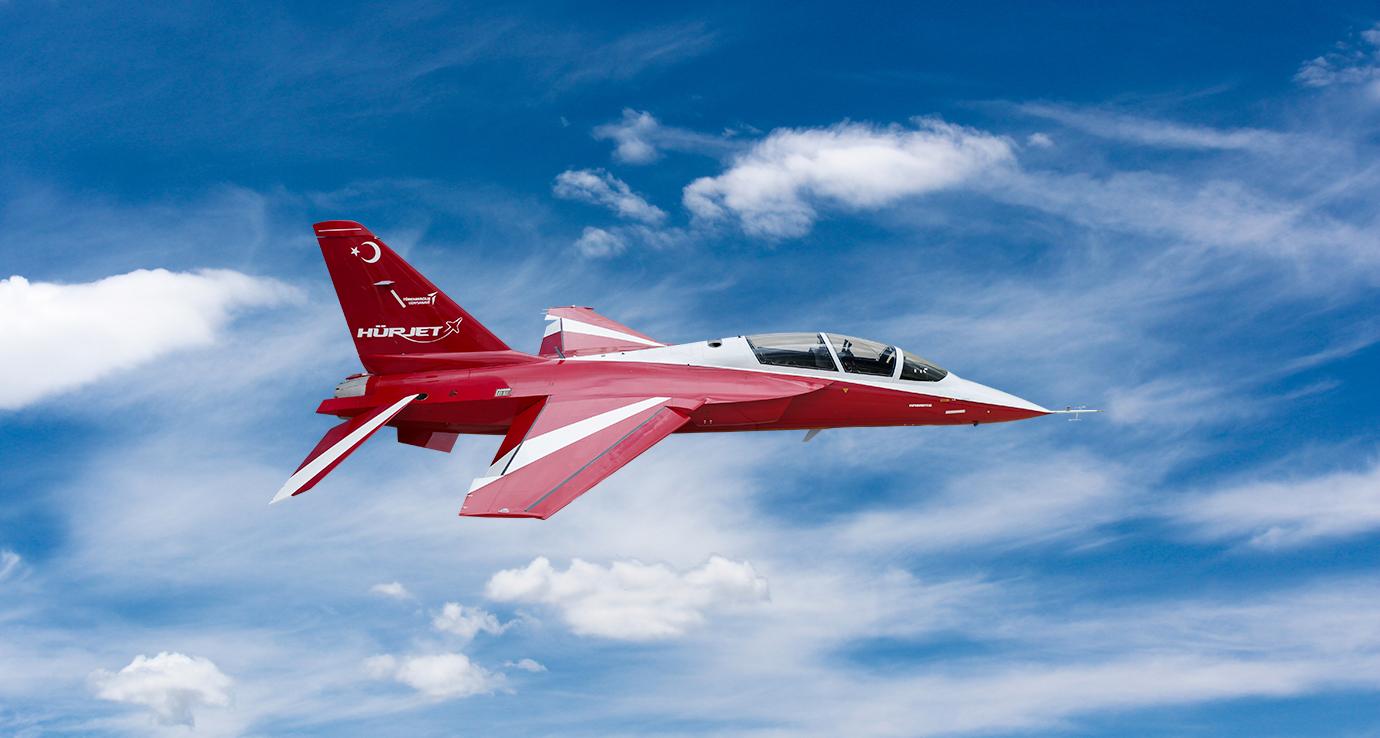
Turkish Aerospace is aggressively marketing its advanced jet trainer and light attack aircraft Hurjet. President and Chief Executive Temel Kotil, exuding confidence in the platform, said, “There is a total market for about 400 Hurjets over the next two decades. This includes over 100 units for the Turkish air force and 300 for export customers.”
On April 25, 2023, Hurjet completed its inaugural test flight, achieving an altitude of 14000 feet and a speed of 250 knots during the test, while remaining airborne for 26 minutes, an official of Turkish Aerospace, the makers of the aircraft, said.
Kotil said Hurjet will receive the same Murad AESA radar that will be installed on F-16 (Özgur Project) and Akinci UCAV. The AESA radar will have a detection/tracking range of 300 km.
“The Murad AESA is a very modern radar. It is a radar development project identical to the most advanced radars currently in the world,” he added.
The single engine aircraft with tandem-seat and modern avionics will fulfil a critical role in modern pilot training through its superior performance characteristics, the official said. The combat variant provides a battlefield force multiplier through a wide range of mission capabilities and an extensive payload, he added.
Powered by a General Electric F404-GE-102 engine, the aircraft is slated to have a maximum speed of Mach 1.4 and a range of 2,222 kilometers (1,200 nautical miles).
“Hurjet aims to replace ageing T-38s as Advanced Jet Trainers (AJT) and F-5s as Acrobatic Team Aircraft of the TuAF,” he said. Though originally designed as a jet trainer, the single-engine, tandem-seat jet will also be equipped with modern avionics and high-performance components to conduct combat missions.
The Hürjet Project, carried out under the coordination of the Turkish Defense Industry Agency, was launched in August 2017 as the Jet Trainer Development Project.
Designed with the goal of 5th-generation training aircraft, Hurjet will be equipped with an advanced mission computer in its modern cockpit. The aircraft will be equipped with state of the art Human Machine Interface (HMI) with minimum conversion time to F-35 and Turkish Fighter.
The aircraft will be supplied with superior radar and sensitive attack systems, and with air and ground communication capabilities, it will reduce threats and risks. Hurjet will be 44.6-feet-long with a wingspan of 31 feet and a payload capacity of 2,721 kilograms.
The aircraft will have 7 weapons stations, three under the wing and one under the fuselage. Hürjet will be able to carry payloads totalling approximately 3 tons.
Considering the multirole aircraft market, Turkish Aerospace has started the Hurjet programme with the intention of targeting the potential in the market with its “cost effective design and production of trainer/light aircraft/system.”
The company hopes to start serial production of the aircraft in 2025, “based on the success of the performance of the initial units.”
From 2026, it will gradually replace the Cold War-era Northrop T-38 Talon as the advanced trainer jet of the Turkish Air Force. According to TAI, the Hürjet will also be able to fulfill close air support missions, as well as conduct air policing. The Hürjet has yet to win an export contract.
It recently competed in a tender held by Malaysia. TA had offered the Hurjet to Royal Malaysian Air Force’s (RMAF) for its requirement of 18 light combat aircraft (LCA). South Korea’s KAI FA-50, India’s HAL Tejas, China’s CATIC L-15, Italy’s Leonardo M-346, and Russia’s MiG-35 were also under consideration.
Ultimately, the Malaysian Ministry of Defense signed a US$920 million contract for 18 KAI FA-50 light fighter jets. Turkey is still pursuing the sale of the jet trainer in the region with the possibility of local production. “ We expect the aircraft to get customers in this region,” the official said.
Malaysia Facility
Recently, Turkish Aerospace built its first engineering and design office in Malaysia’s Putrajaya city, the first in Southeast Asia, as part of its efforts to collaborate on various platforms including unmanned aerial vehicles (UAVs) and to further solidify its presence in Malaysia.
“The new facility initially has provision for 20 engineers, who will be imparted training in designing. We are ready to collaborate on a range of projects, including UAVs, jet trainers, helicopter projects, and global aviation ecosystem modernisation programmes,” he added.
The company, he said, is also open to technology transfer as well as local production of components and spare parts.
“Whether we win the contract or not, some of the Hürjet electronics will be built in Malaysia as we would still need those equipment,” the official added.

Headquartered in Singapore with reporters spread across all major regions, GBP Aerospace & Defence is a leading media house that publishes three publications that serve the aerospace and defence sector - Asian Defence Technology, Asian Airlines & Aerospace and Daily News. Known industry-wide for quality journalism, GBP Aerospace & Defence is present at more international tradeshows and exhibitions than any other competing publication in the region.
For over three decades, our award-winning team of reporters has been producing top-notch content to help readers stay abreast of the latest developements in the field of commercial aviation, MRO, defence, and Space.
Copyright 2023. GBP. All Rights Reserved.